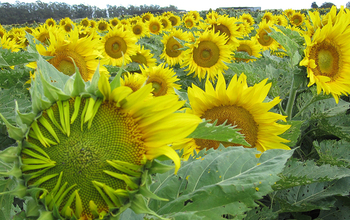Plant biologists discover how sunflowers use internal circadian timing to follow the sun
 When they're mature, sunflowers stop tracking the sun and instead face solely eastward. Credit and Larger Version |
August 4, 2016
It's summertime, and the fields of Yolo County, Calif., are filled with rows of sunflowers, dutifully facing the rising sun.
At the nearby University of California, Davis, plant biologists have now discovered how sunflowers use their internal circadian "clocks," acting on growth hormones, to follow the sun during the day as they grow.
"It's the first example of a plant's clock modulating growth in a natural environment, and having real repercussions for the plant," said Stacey Harmer, a plant biologist at UC Davis and senior author of a paper reporting the discovery published this week in the journal Science.
Harmer is a molecular biologist who studies circadian clocks, usually in the plant Arabidopsis, which is smaller than a sunflower. Previously, Harmer had discovered links between "clock" genes and the plant hormone auxin, which regulates growth.
Harmer and her collaborator Benjamin Blackman of UC Berkeley needed the next example, and they found it in the sunflower.
The research was funded by the National Science Foundation's Plant Genome Research Program.
"Just like people, plants rely on the daily rhythms of day and night to function," said the program's director, Anne Sylvester. "Sunflowers, like solar panel arrays, follow the sun from east to west. These researchers tapped into information in the sunflower genome to understand how and why sunflowers track the sun."
Swinging east then west
Growing sunflowers begin the day with their heads facing east, swing west through the day, and turn back to the east at night.
"The plant anticipates the timing and the direction of dawn, and to me that looks like a reason to have a connection between the clock and the growth pathway," Harmer said.
This sunflower behavior had been described by scientists as far back as 1898, but no one had thought to associate it with circadian rhythms.
Plant biologist Hagop Atamian, also of UC-Davis, along with Harmer and Blackman carried out a series of experiments with sunflowers in the field, in pots outdoors, and in indoor growth chambers.
By staking plants so they couldn't move, or turning potted plants around daily so they were facing the wrong way, the scientists showed that they could disrupt the sunflowers' ability to track the sun. The plants also showed a decrease in leaf area and biomass compared with control plants.
When the sunflowers were moved into an indoor growth chamber with immobile overhead light, they continued to swing back and forth for a few days. That's the kind of behavior you would expect from mechanism driven by an internal clock, Harmer said.
Finally, the indoor plants did start tracking "the sun" again when the apparent source of lighting was moved across the growth chamber by turning adjacent lights on and off during the day.
The plants could reliably track the movement and return at night when the artificial day was close to a 24-hour cycle, but not when it was closer to 30 hours.
Growth mechanisms
How do the plants move their stems during the day? Atamian put ink dots on the stems and filmed them with a video camera. On a time-lapse video, he could measure the changing distance between the dots.
When plants were tracking the sun, the east side of the stem grew more rapidly than the west side, he found. At night, the west side grew faster as the stem swung the other way. The team identified a number of genes that were expressed at higher levels on the sunward side of the plant during the day, or on the other side at night.
Harmer said that there appear to be two growth mechanisms at work in the sunflower stem. The first sets a basic rate of growth for the plant, based on available light. The second, controlled by the circadian clock and influenced by the direction of light, causes the stem to grow more on one side than another, and therefore sway east to west during the day.
As the sunflower matures and the flower opens up, overall growth slows and the plant stops moving during the day and settles down facing east. This seems to be because the circadian clock ensures that the plant reacts more strongly to light early in the morning than in the afternoon or evening, so it gradually stops moving westward during the day.
Why face the sun?
Why do mature sunflowers face east?
The researchers grew sunflowers in pots in the field, and rotated some of them to the west. By measuring the flowers with an infrared camera, they found that the east-facing sunflowers heated up more quickly in the morning -- and also attracted five times as many pollinating insects. Heating up west-facing flowers with a portable heater brought more pollinators back to the flowers.
"Bees," said Harmer, "like warm flowers."
Additional co-authors of the paper are Nicky Creux of UC Davis, and Evan Brown and Austin Garner of the University of Virginia.
-NSF-
cdybas@nsf.gov
Andy Fell, UC Davis, (530) 752-4533,
ahfell@ucdavis.edu
Related WebsitesNSF Grant: Investigating the Mechanistic Basis and Adaptive Significance of the Coordination of Plant Growth by External and Internal Cues:
https://www.nsf.gov/awardsearch/showAward?AWD_ID=1238040&HistoricalAwards=false
Ten things to know about the flowers of fall: Sunflowers: https://www.nsf.gov/discoveries/disc_summ.jsp?cntn_id=132980
The National Science Foundation (NSF) is an independent federal agency that supports fundamental research and education across all fields of science and engineering. In fiscal year (FY) 2016, its budget is $7.5 billion. NSF funds reach all 50 states through grants to nearly 2,000 colleges, universities and other institutions. Each year, NSF receives more than 48,000 competitive proposals for funding and makes about 12,000 new funding awards. NSF also awards about $626 million in professional and service contracts yearly.
Useful NSF Web Sites:
NSF Home Page:
https://www.nsf.gov
NSF News:
https://www.nsf.gov/news/
For the News Media:
https://www.nsf.gov/news/newsroom.jsp
Science and Engineering Statistics:
https://www.nsf.gov/statistics/
Awards Searches:
https://www.nsf.gov/awardsearch/

Honeybees visit a mature sunflower. Here, the bees are collecting nectar rather than pollen.
Credit and Larger Version

A sunflower just before maturation. Soon the yellow ray petals will unfold.
Credit and Larger Version

Sunflower being visited by a native bee, the "ultra green sweat bee."
Credit and Larger Version

This mature sunflower was imaged using forward-looking infrared (FLIR) imaging; bees are white.
Credit and Larger Version

Young sunflowers are good solar-trackers, following the sun by day and re-orienting at night.
Credit and Larger Version
The National Science Foundation (NSF)
Guillermo Gonzalo Sánchez Achutegui
ayabaca@gmail.com
yabaca@hotmail.com
ayabaca@yahoo.com
Inscríbete en el Foro del blog y participa : A Vuelo De Un Quinde - El Foro!

No hay comentarios:
Publicar un comentario